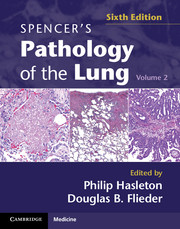Book contents
- Frontmatter
- Dedication
- Contents
- Contents
- Contributors
- Foreword to the First Edition
- Preface to the Sixth Edition
- Acknowledgements
- Chapter 1 The normal lung: histology, embryology, development, aging and function
- Chapter 2 Lung specimen handling and practical considerations
- Chapter 3 Congenital abnormalities and pediatric lung diseases, including neoplasms
- Chapter 4 Pulmonary bacterial infections
- Chapter 5 Pulmonary viral infections
- Chapter 6 Pulmonary mycobacterial infections
- Chapter 7 Pulmonary mycotic infections
- Chapter 8 Pulmonary parasitic infections
- Chapter 9 Acute lung injury
- Chapter 10 Interstitial lung diseases
- Chapter 11 Metabolic and inherited connective tissue disorders involving the lung
- Chapter 12 Hypersensitivity pneumonitis
- Chapter 13 Sarcoidosis
- Chapter 14 Occupational lung disease
- Chapter 15 Eosinophilic lung disease
- Chapter 16 Drug- and therapy-induced lung injury
- Chapter 17 Chronic obstructive pulmonary disease and diseases of the airways
- Chapter 18 Pulmonary vascular pathology
- Chapter 19 Pulmonary vasculitis and pulmonary hemorrhage syndromes
- Chapter 20 The pathology of lung transplantation
- Chapter 21 The lungs in connective tissue disease
- Chapter 22 Benign epithelial neoplasms and tumor-like proliferations of the lung
- Chapter 23 Pulmonary pre-invasive disease
- Chapter 24 Epidemiological and clinical aspects of lung cancer
- Chapter 25 Lung cancer staging
- Chapter 26 Immunohistochemistry in the diagnosis of pulmonary tumors
- Chapter 27 Adenocarcinoma of the lung
- Chapter 28 Squamous cell carcinoma of the lung
- Chapter 29 Large cell carcinoma and adenosquamous carcinoma of the lung
- Chapter 30 Salivary gland neoplasms of the lung
- Chapter 31 Neuroendocrine tumors and other neuroendocrine proliferations of the lung
- Chapter 32 Sarcomatoid carcinomas and variants
- Chapter 33 Mesenchymal and miscellaneous neoplasms
- Chapter 34 Pulmonary lymphoproliferative diseases
- Chapter 35 Metastases involving the lungs
- Chapter 36 Diseases of the pleura
- Index
- References
Chapter 31 - Neuroendocrine tumors and other neuroendocrine proliferations of the lung
Published online by Cambridge University Press: 05 June 2014
- Frontmatter
- Dedication
- Contents
- Contents
- Contributors
- Foreword to the First Edition
- Preface to the Sixth Edition
- Acknowledgements
- Chapter 1 The normal lung: histology, embryology, development, aging and function
- Chapter 2 Lung specimen handling and practical considerations
- Chapter 3 Congenital abnormalities and pediatric lung diseases, including neoplasms
- Chapter 4 Pulmonary bacterial infections
- Chapter 5 Pulmonary viral infections
- Chapter 6 Pulmonary mycobacterial infections
- Chapter 7 Pulmonary mycotic infections
- Chapter 8 Pulmonary parasitic infections
- Chapter 9 Acute lung injury
- Chapter 10 Interstitial lung diseases
- Chapter 11 Metabolic and inherited connective tissue disorders involving the lung
- Chapter 12 Hypersensitivity pneumonitis
- Chapter 13 Sarcoidosis
- Chapter 14 Occupational lung disease
- Chapter 15 Eosinophilic lung disease
- Chapter 16 Drug- and therapy-induced lung injury
- Chapter 17 Chronic obstructive pulmonary disease and diseases of the airways
- Chapter 18 Pulmonary vascular pathology
- Chapter 19 Pulmonary vasculitis and pulmonary hemorrhage syndromes
- Chapter 20 The pathology of lung transplantation
- Chapter 21 The lungs in connective tissue disease
- Chapter 22 Benign epithelial neoplasms and tumor-like proliferations of the lung
- Chapter 23 Pulmonary pre-invasive disease
- Chapter 24 Epidemiological and clinical aspects of lung cancer
- Chapter 25 Lung cancer staging
- Chapter 26 Immunohistochemistry in the diagnosis of pulmonary tumors
- Chapter 27 Adenocarcinoma of the lung
- Chapter 28 Squamous cell carcinoma of the lung
- Chapter 29 Large cell carcinoma and adenosquamous carcinoma of the lung
- Chapter 30 Salivary gland neoplasms of the lung
- Chapter 31 Neuroendocrine tumors and other neuroendocrine proliferations of the lung
- Chapter 32 Sarcomatoid carcinomas and variants
- Chapter 33 Mesenchymal and miscellaneous neoplasms
- Chapter 34 Pulmonary lymphoproliferative diseases
- Chapter 35 Metastases involving the lungs
- Chapter 36 Diseases of the pleura
- Index
- References
Summary
Introduction
Cells with the neuroendocrine phenotype synthesize and secrete amine or peptide hormones that regulate local physiological processes. They act in concert with systemic neural and endocrine control systems. These cells have features of both neurons and of endocrine cells, hence their name. Whether scattered as individual cells within epithelia, as in the airways or gut, or aggregated into larger structures, such as the pancreatic islets, neuroendocrine cells are characterized by their morphological uniformity and high degree of organization; that is to say, they “look” neuroendocrine. Their ultrastructural hallmark is the neurosecretory or dense core vesicles (DCVs) that store and release their secretory products (see Chapter 1). Components of these and other secretory vesicles, together with a variety of membrane proteins and enzymes, endow neuroendocrine cells with a characteristic antigenic profile. These unique features are recapitulated in the neoplasms that differentiate along neuroendocrine lines. With this particular phenotype, morphological, functional and antigenic characteristics allow such tumors to be recognized as neuroendocrine.
It is not surprising the lungs give rise to tumors characterized by neuroendocrine differentiation, since a widely dispersed and dynamic population of peptide and amine-secreting pulmonary neuroendocrine cells (PNCs) is an integral part of the respiratory epithelium (see Chapter 1). Why neuroendocrine differentiation is so common amongst pulmonary tumors is an unanswered question. The prevalence of such neoplasms in the lungs contrasts markedly with that in other epithelia, such as those lining the gastrointestinal, urinary and reproductive tracts, where neuroendocrine cells are also found, but the corresponding tumors are rare.
- Type
- Chapter
- Information
- Spencer's Pathology of the Lung , pp. 1151 - 1185Publisher: Cambridge University PressPrint publication year: 2000



